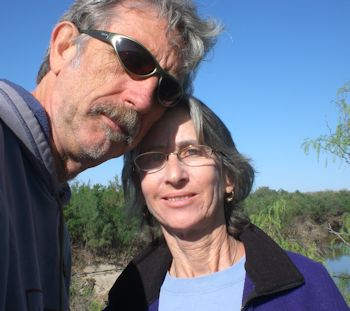BUXTON — Jim and Marcia Lyons have volunteered with the N.C. Coastal Federation on and off for about 10 years, and their devotion to the recent living shoreline project at Durant’s Point in nearby Hatteras earned them a Pelican Award from the federation.
Sarah Hallas, coastal education coordinator for the federation’s office in Manteo, said it is sometimes hard for the small staff to have the presence in remote Hatteras that they would like. The Lyons, residents of Buxton, consistently help spread the word of federation projects and bring new volunteers to workdays there.
Supporter Spotlight
They are both very dedicated to protecting “their area of Hatteras that is very special and unique,” Hallas noted.
Durant’s Point is a privately owned strip of land that shelters Hatteras Harbor, and it was eroding at a rate of five to 10 feet a year. “If that was to wash away, the harbor would be next,” Hallas said, noting numerous commercial fishermen are based in the harbor, which is also culturally and ecologically significant.
 Jim and Marcia Lyons have been steadfast federation volunteers and are dedicated to protecting the natutal resources of Hatteras Island. |
The living shoreline approach to shoreline stabilization involves controlling erosion with the least environmental impact; in fact, it actually creates estuarine habitat.
Creating a living shoreline for Durant’s Point began in March 2011, after grant funding was secured.
“We planted there the last two spring seasons, [and the Lyons] were instrumental in getting thousands of marsh grass plugs in the ground,” Hallas said.
Supporter Spotlight
Marcia had formerly helped plant marsh grasses in a similar living shoreline project in Ocracoke, and said she loves that the federation promotes the natural way of stabilizing shorelines, as opposed to wooden bulkheads or stone walls.
“It’s so much work to get the permits and all that beforehand,” Marcia stated. “I was really excited when it happened here.”
One of the federation’s main goals, Marcia noted, is raising awareness of the values submerged aquatic grasses and tidal grasses in salt marshes bring to whole estuary. The grasses provide habitat for aquatic life while buffering the land from the winds and tides.
Since Durant’s Point is only accessible by water, Jim’s use of his boat to transport people and supplies was also crucial to the project. The federation didn’t have a workboat at that time, Hallas said.
Jim also helped transport a graduate student, Rachel Gittman, who was doing studies of underwater grasses in that area.
“I helped take her out whenever she came, which was a lot,” Jim said, noting that he thought it was fun to work with both the young researcher and the federation.
“It was a lucky set of circumstances; lucky for me, lucky for Rachel, lucky for the coastal federation,” he said. “I’m very honored. It was a lot of hours, (but) not really a lot of difficult hours.”
Jim, a Norfolk, Va., native who moved to Buxton in 1973, said he has always been involved in fishing, hunting and surfing, and he knew Jan DeBlieu, who worked for the coastal federation, very well.
“We helped Jan with some research for a water quality study [years ago],” he said. “We went to eight or nine workshops, talked about estuarine concerns. I took water samples from Hatteras Island.”
Jim believes that an “estuarine environment can be a healthy, productive resource that can benefit everyone if managed properly.” The water “has certainly given me lots of enjoyment,” he said.
The local waters’ organically raised food can perpetuate itself forever if taken care of, he said, and “should be incredibly productive.”
But since 1973, he has seen a decline in the Pamlico Sound’s food production.
Many of his friends are commercial fishermen, which he describes as fishing by proxy for the numerous people who like to eat seafood but do not necessarily want to go catch it. For the fishermen’s livelihood and the health of the area in general, he says it’s essential to protect water quality and habitat.
The living shoreline project at Durant’s Point helps do just that.
“It’s nice to think we can protect shorelines and actually increase biodiversity and biomass with the right kind of structures conducive to small animals [and] vertebrates.”
His wife agrees.
A native of Boston, Mass., who moved here in 1976 and worked for the National Park Service for 32 years, Marcia said she has always loved coastal systems and salt marsh systems.
“They are great places for exploring, great places for education,” she said.
One of her favorite activities while working for the Park Service was taking people out with nets and exploring the shallow waters. “It was always like a little treasure hunt,” she recalls. “People were always surprised how productive (the waters were).”
Sharing a love for the local wetlands, Jim and Marcia Lyons regularly put their beliefs to work in preserving the environment.







